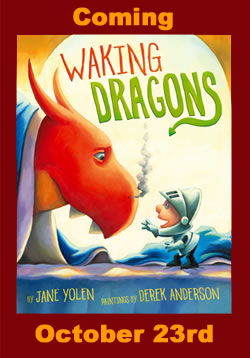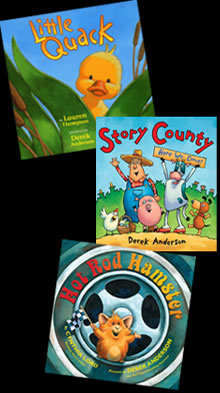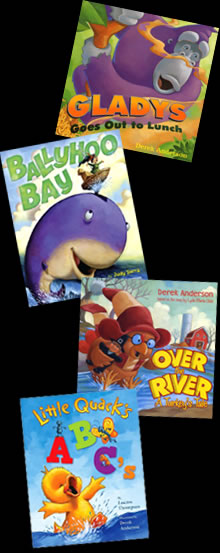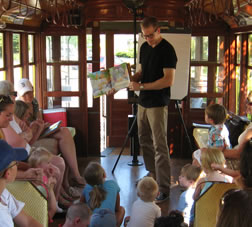Friday, June 15th, 2012
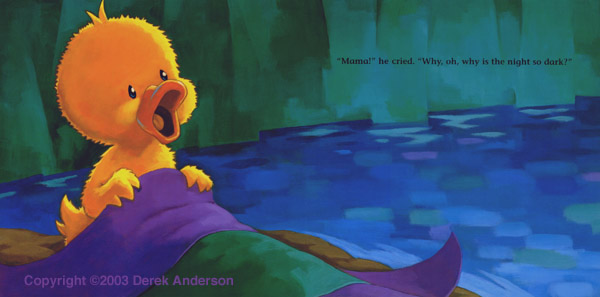
Sketching by Candlelight
Life as a Book Artist in the 19th...
I mean 21st Century
The second time my books were affected by living in Minneapolis was in the summer of 2003. The Midwest is well known for our brutal winters, especially Minnesota. What many people don't know is that our electrical storms in the summer can be downright frightening. They can last for hours at a time with streak lightning splitting the sky and thunder so explosive, the crashes rattle your walls and can be felt down in the depths of your soul. There's nothing you can do, you just have to wait for them to pass.
In July 2003, I was already published. Little Quack had just come out that spring and I'd already completed the paintings for the second book in the series, Little Quack's Hide and Seek. I was back on deadline working on sketches for what would become Little Quack's Bedtime when a series of dangerous storms hit. These weren't the nice summer soakers you can enjoy. They were electrical beasts accompanied by hail and eighty mile an hour straight-line winds. If you don't know what straight-line winds are, imagine a tornado that doesn't bother to spin. The wind shoots across the land like an arrow causing damage to everything it comes into contact with. You can have two trees side by side in the same yard and one will be left alone while the other, a few short feet away, is toppled as if King Kong had just run through your neighborhood and kicked it over, pulling up roots from deep beneath the earth's surface.
The storms that came that night knocked down trees, took out power lines and caused flooding all over the Twin Cities. We ended up without power for three days. I had to spend the entire next day cleaning up branches and debris that littered our yard. I was exhausted by evening, but I was near the end of my sketch deadline, and having taken the day off to work outside, I had no choice- I had to get back to work on my sketches that night. The lack of power presented a problem. There wasn't electricity, so I couldn't turn on any lights and it's impossible to sketch in the dark. Even the streetlights were out. My wife was out of town at the time and I didn't want to leave my dog alone without lights or air conditioning. It was time to get creative. I found a flashlight and went through the house, searching every shelf, closet and cabinet collecting candles. I came up with about fifteen in all. I arranged them on the kitchen table and lit every one of them. The soft, flickering candlelight wasn't ideal, but it was certainly enough to see what I was drawing. I was still working at one o'clock in the morning when my phone rang.
"Hey Derek," said my neighbor. "It's Dave, across the street. I was wondering if I could run an extension cord across the street."
"Why?" I said, perplexed.
"We were hoping we could plug in our refrigerator," he said. "We just got home and saw your lights were back on." I couldn't believe the light from my candles could possibly appear that bright from outside.
"You can," I said. "But I don't think it'll do you any good. We don't have power, either." I tried to explain that I was burning candles so I could work on my book. I'm not sure he believed me at first, but we ended up having a good laugh about it.
Thanks to the candles, I did finish my sketches on time, although the sketch I was working on that night ended up with more than a few wax drippings on it.
It's easy to take our most basic conveniences for granted. We can have light by flipping a switch, music by pushing a button, and talk to anyone anywhere anytime by picking up the phone. It hasn't always been that way. Can you imagine life without those creature comforts? We've become so addicted to our conveniences, we've forgotten what it's like to just be- to be with our families, to be with our friends, to be creative. Do you ever wonder how you would cope without texting or email or television? You should try taking a little vacation from your gadgets. My guess is you'd do just fine. Even thunderstorms can give us little gifts. There really are lessons at every turn in this life, sometimes you just have to look for them.

Friday, June 8th, 2012
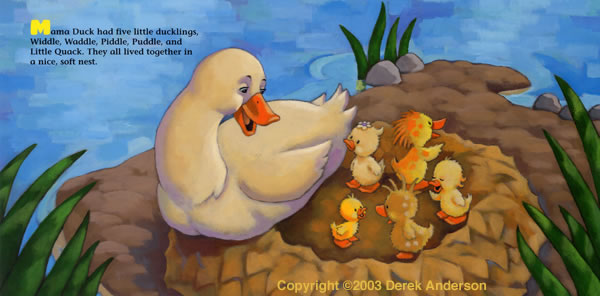
The Lost Quacks
A Cautionary Tale... Sort of
When you make your living as an author and illustrator, it doesn't matter where you live... most of the time. There have only been two times in my life that the choice of where I live has affected my work in the world of publishing.
The first was in March 2002. I was just finishing the paintings for my very first picture book, Little Quack. I didn't have a lot of time to do the paintings- I'd only been given forty days to complete the pictures for the entire book. I couldn't argue about the deadline at the time, it was my first picture book and the first time I'd ever worked with Simon & Schuster. So I'd spent the last forty days working fifteen hours a day to complete the paintings. It was a Thursday when I packed them up and headed off to the airport to ship them out. I remember a lot of thoughts and emotions swimming around in my head as I navigated through the late afternoon traffic in Minneapolis. I'd worked for years to get this opportunity. I'd weathered endless rejection and fought to get the chance to work with one of the largest children's book publishers in the world. This was my dream coming true. I'd just taken on a picture book and finished it. I'd created characters, sketches and paintings that all worked together in some sort of harmony. All I had left to do was send them off to New York to meet the deadline. I was so caught up in my thoughts, I didn't even notice the snow storm that was quickly moving in. I arrived at FedEx, left my package in their care and went home to collapse. I was physically and emotionally exhausted. While I relaxed and tried to enjoy my new accomplishment, the snow storm that I'd hardly noticed turned into a blizzard.
The next morning, I got up and tracked the package. It hadn't arrived at Simon & Schuster yet, but I wasn't worried. I knew that the tracking information wasn't kept up-to-the-minute and it had most likely been delivered. I kept checking in throughout the morning and by early afternoon, I called my editors, Kevin Lewis and Alyssa Eisner to see if the package had arrived. It hadn't. I made a quick call to FedEx and they assured me it would be delivered by the end of the day. It wasn't. I was getting progressively more anxious because after repeated phone calls, no one seemed to be able to tell me anything.
After a sleepless night, I called FedEx on Saturday morning and they once again assured me my package would be delivered by noon. It wasn't. I stayed in close touch with them throughout the afternoon and at three o'clock, one of their agents finally confessed that the blizzard had caused widespread delays and interruptions in their deliveries and they had no idea where my package was. I was heartbroken. A powerful imagination can be an incredible gift. It can also be your undoing. For the rest of the weekend, I was imagining my hard work skewered on a forklift somewhere in upstate New York or misplaced in some random warehouse in New Jersey, never to be found again. I tried to imagine how I would ever be able to paint all those paintings again. I couldn't. A blizzard was about to end my career in children's books and I hadn't even really begun.
On Monday morning, I tracked the package and to my surprise, it had been delivered. I made a quick call to my editors and asked them to please find it and tell me that everything was okay. I didn't hear back from them until late that afternoon. It wasn't good news. Alyssa said the package seemed to have been misplaced in the mailroom, but not to worry.
On Tuesday morning, five days after I'd shipped it off, Alyssa called. "You can rest easy, Derek," she said. "We have the package. There's no damage and the art is absolutely beautiful." The rest, of course, is history. But looking back, Little Quack is a book that almost never was. The weather could have changed everything I'd worked so hard for.
I've learned to expect the unexpected, not only in this business, but in this life. Life is an adventure. Sometimes we're in control of the adventure and sometimes we're not. When we're not, it's best to hold on tightly and try to enjoy the ride. It may not always take you where you want to go, but that's part of the journey. None of this would be fun or even interesting if we always ended up exactly where we were headed.
Coming next week... The Second Tale of Woe!

Friday, June 1st, 2012
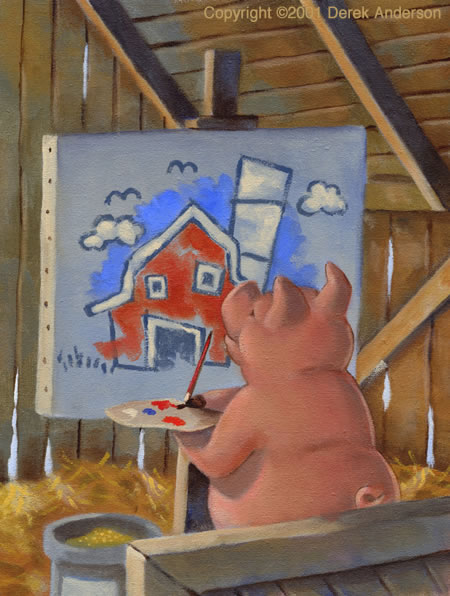
Before I Was Published
While I paint a new cover for Waking Dragons and get started on paintings for the next Hot Rod Hamster book (more about that soon), I thought I would take a look back at the days before I was published.
I have to admit that it wasn't an easy time. When you have a dream and you want it more than anything else in the world, it's hard to be patient. Making books was all I wanted to do and yet I never knew if that dream would come true. The odds certainly weren't in my favor. I could only work toward my goal and hope that I was painting the right pictures, writing the right stories and sending them to the right publishers. There's no way to know, of course. Getting published takes a lot of hard work and more than a little luck. There were only a few things that I was in control of- doing the best work I was capable of, being selective about what I sent out, and then getting that work in front of the editors and art directors that make those decisions. The rest had to be left to fate.
One of the pieces I sent off to publishers back in those days was a pig painting a picture of a barn (shown above). I think I painted it in 2000 or 2001. Back then I painted all of my pictures on a tightly woven canvas. It was really the surface that I learned to paint on and I liked the texture it gave the final paintings. I always liked how this piece turned out and it's one of the few, from that time, that I feel still works well. It's hard to look back at pieces I painted more than ten years ago because all I can see is everything that's wrong with them. When you begin as a painter, you're trying to get a feel for the brushes and paint and what they can do. It isn't until you get comfortable with the medium that you begin to innovate and try things that you never would have attempted before.
There are no rules for developing a style. A personal style comes from hard work, a willingness to make mistakes and more than anything, honesty. The goal of the artist is not only to find your strengths, but to know your weaknesses and ultimately discover and develop what makes your own work unique. Looking back, I think the "painting pig" piece was a step in the right direction. It has an interesting subject, strong composition and a competent palette. The narrative, though, is still the most effective part of this piece. Though you can't see the pig's face, he's obviously pondering what comes next. It's something, I'm quite sure, I was pondering myself.

Friday, May 25th, 2012
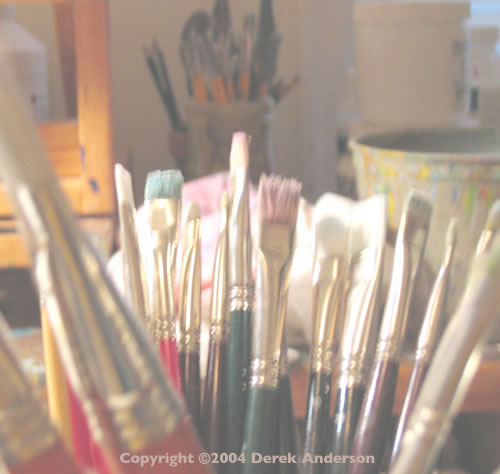
Creating Book Covers:
To Whisper, Speak or Shout?
That's the Question
~ Part Two... Will Have to Wait ~
You're not going to believe this. The day that I posted about creating book covers last week, I received a call from my publisher about the cover of my new book. Waking Dragons is about to go to press and I'm suddenly faced with changing the cover. To say the timing of this is ironic would be an understatement.
I had every intention of unveiling the cover of Waking Dragons today, but I can't. I can only promise you that I'll write about all of this soon. In the meantime, I can offer you a very timely and relevant quote...
The only way to make sense of change
is to plunge into it, move with it,
and join the dance.
That's all for today, I have a painting to do.

Friday, May 18th, 2012

Creating Book Covers:
To Whisper, Speak or Shout?
That's the Question
~ Part One ~
"Never judge a book by its cover." At least that's how the saying goes. Are you kidding me? That's like saying don't trust your eyes or instincts. We do make judgments based on what we see, it's human nature. If you didn't think it mattered, you wouldn't bother to comb your hair or dress up for work or school. And you wouldn't care at all about the appearance of anything you bought or owned. It does matter. You're drawn to certain colors, shapes, styles and ideas for a reason. In some situations, that first glance is all we have. We gather information and make an evaluation in a fraction of a second. The point of the saying is, of course, that there's depth and substance beyond what you first see. It's the same with books. Whatever you happen to see on the outside- there's depth and substance beneath. My job, when I'm making a cover, is to make you want to know more about that depth and substance.
An artist should never underestimate the power of a good cover. Covers are more important than you might think. Besides the title and description, it's all we have to entice a reader to pick up the book. The cover speaks for everything else. It makes a promise- it gives the reader a preview of what he or she can expect to find when they dive into its pages. The cover says, "Take a look, you won't be sorry."

Choosing one image to represent everything inside the book is a tall order. Though they're never easy, some of my covers have definitely come easier than others. With Little Quack, the cover image was, I think, the only one I proposed. But the next in the series, Little Quack's Hide and Seek, wasn't nearly as clear cut.
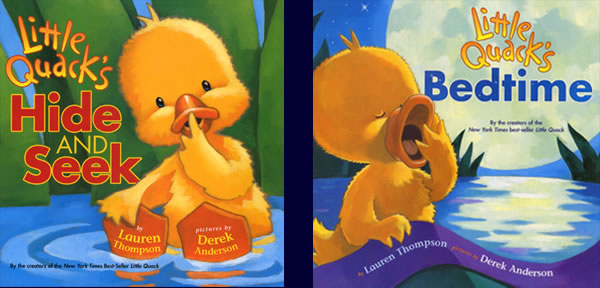
When you're making a sequel, you want to use a similar approach, but it needs to feel unique and different. You want readers to recognize both the style and character, but to know, instantly, that it's not the same book. I did something like twenty-five finished sketches for the cover of Little Quack's Hide and Seek before we finally settled on one that felt right. It's odd that that cover was so difficult, because the cover of Little Quack's Bedtime, the next in the series, came almost instantly.
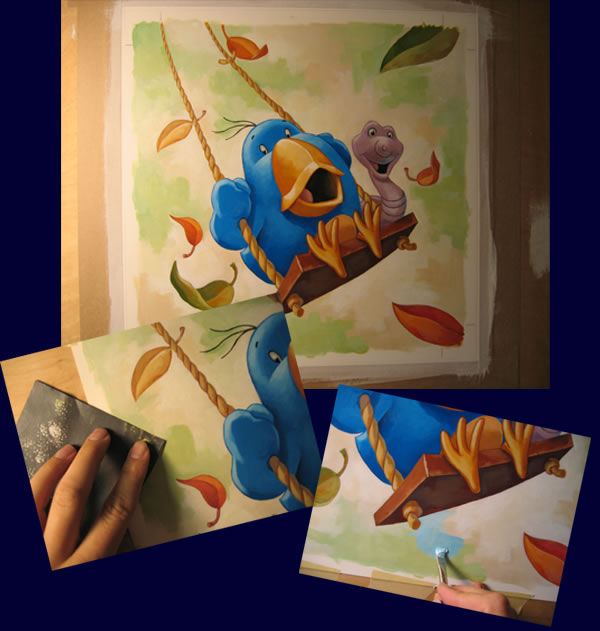
Occasionally, I'll finish a painting for a cover and it will need to be reworked. With Blue Burt and Wiggles, I was really after an autumn look and feel. I painted the background in soft green and beige tones that felt like the brambly fall season the book is set in. When the type was laid in, the image just wasn't popping the way it should. I discussed it with my editor at the time, Alyssa Eisner, and we agreed that it needed more work.
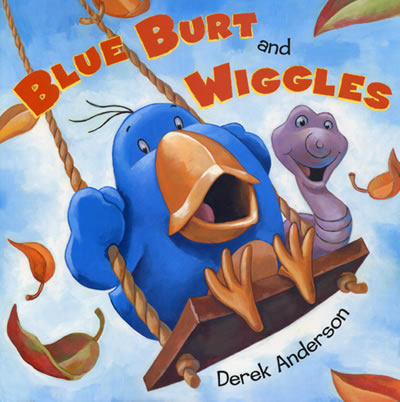
I'm not a big fan of changing paintings- it requires sanding down hours of work, but sometimes there's just no way around it. I searched my paint drawer for the right colors and ended up using a crisp sky blue. The color is still found in the fall season, and helped push the leaves and the characters forward to get just the pop we were looking for.
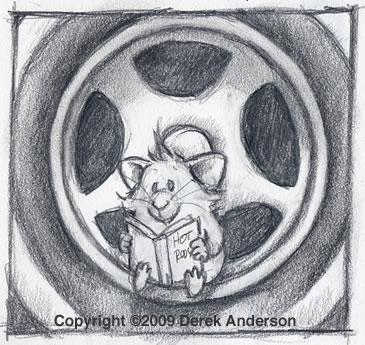
When I start a new book, I have no idea what I'll do with the cover. And when I don't know what to do, I go to my sketchbook and play. An artist has to be willing to experiment, it comes with the territory. We're inventors trying to discover the right combination of ideas, shapes and colors. Sometimes we have to find all the combinations that don't work before we find the one that will. With Hot Rod Hamster, I actually submitted a rough sketch that I thought would make a great back cover. It was my editor, Leslie Budnick, and art director, Marijka Kostiw, at Scholastic that saw the potential in the sketch and suggested we use it for the front.
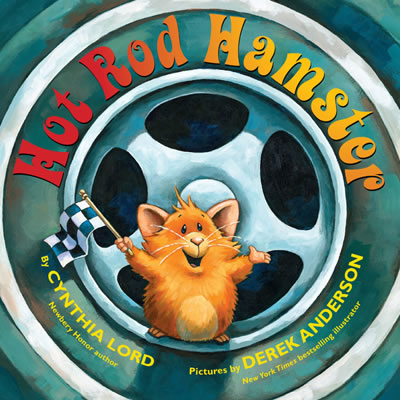
The sketch needed a few changes to make it a strong cover. Since Hot Rod Hamster is about a race, I needed to give Hamster a more dynamic pose and I gave him a checkered flag to help push the racing theme. But that all came fairly quickly.
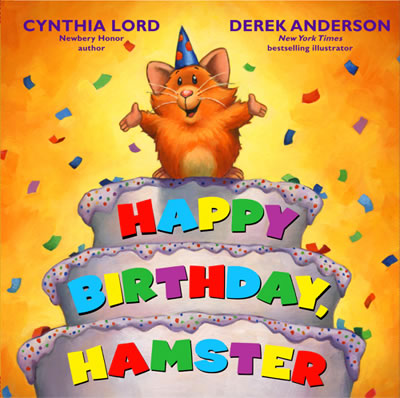
The cover is almost always the last thing I paint. There have been a few exceptions. Once in a while, I'll get a late start on the paintings and the publisher will need the cover for the catalog or for marketing. In that case, I'll have to stop work on the interior pieces to paint the cover. With Happy Birthday, Hamster, the cover was actually the first image I painted. That wasn't a problem because the book was a sequel, so I already knew the character and palette well. But if I had my way, I would always do the cover last. By then, I've spent months painting the characters and their world and I have a much better feel for what's going on inside the book. That gives me the ability to create an honest moment for the cover that will give a glimpse of the heart and fun that lies within.
Coming next week... Creating Book Covers, Part Two


